REMAINS OF IRONWORKS
Very little remains above ground of the hundreds of bloomeries, forges and furnaces that were once active across the Weald and at only two sites are there structures and earthworks that show something of what had formerly been there.
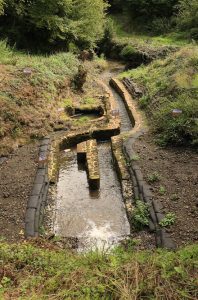
NORTH PARK FURNACE, FERNHURST, WEST SUSSEX
A Scheduled Ancient Monument
(National Grid Reference SU 8795 2820)
This site, which was in operation from 1614 until 1776, lies adjacent to a public bridleway (West Sussex 1265) that runs south from Lower Lodge Farm, Vann Road, west of Fernhurst village. Privately owned, it has recently undergone considerable restoration to the spillway and consolidation of the surviving wheel pits, all of which can be seen easily from the bridleway.
Historical information about this site from the WIRG Online Database can be viewed HERE
For further information see the Fernhurst Furnace Preservation Group website
ASHBURNHAM FURNACE, EAST SUSSEX
A Scheduled Ancient Monument
(National Grid Reference TQ 6857 1711)
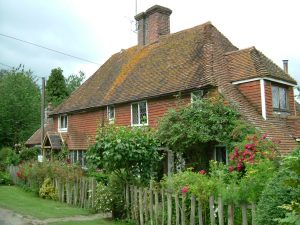
Working from about 1550 until 1813, and the last furnace to be in operation in the Weald, this secluded site is also privately owned but a certain amount can be seen from the public bridleways that pass through it and are accessed from Lakehurst Lane, to the north (ASH/3/1), Penhurst Lane, to the north-east (PEN/2/1), and Forge Lane to the south (PEN/1/1). One of the bridleways passes the ironworkers’ cottages while the other crosses the stream that ran from one of the furnaces and in which large masses of slag, called ‘bears’, can be seen.
An illustrated description of this site is available HERE.
Historical information about this site from the WIRG Online Database can be viewed HERE
RURAL LIFE CENTRE, Reeds Road, Tilford, Farnham, Surrey, GU10 2DL
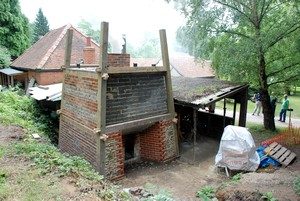
A half-scale reconstruction of a Wealden blast furnace and forge hammer has been built at the Centre and is open to visitors. Although it does not make iron, a waterwheel operates the furnace bellows and the hammer and gives visitors a good idea of the appearance of these mechanisms at work. A short video sequence filmed during the Wealden Iron Research Group’s AGM at Tilford in 2011 can be viewed. Also on display is an original section of the railings from St Paul’s Cathedral in London, which were cast in the Weald in the early-18th century. Further information about the Centre
IRON ARTEFACTS
FIREBACKS
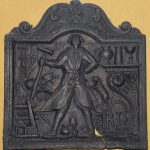
Firebacks were cast by pouring molten iron into a sand mould. The mould was created by pressing objects (often lengths of rope but also everyday items), prepared stamps (such as letters and numerals, as well as heraldic devices) or entire wooden patterns of the intended casting into a bed of clay-impregnated sand. The Weald probably produced more firebacks than any other region in Britain. Anne of Cleves House, Lewes has the United Kingdom’s largest collection of firebacks and two rare, original fireback patterns.
See more about this fireback. Discover more about iron firebacks.
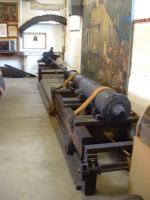
ANNE OF CLEVES HOUSE, 52 Southover High Street, Lewes, East Sussex, BN7 1JA
The best museum display devoted to the iron industry in the Weald is in Anne of Cleves House Museum in Lewes, which is run by the Sussex Archaeological Society. This shows you how iron ore, mined locally, was smelted in water-powered blast furnaces to make iron and how cannon were cast. There is also on display a boring bar recovered from a garden at Stream Furnace Mill, Chiddingly.
The Iron Gallery is currently closed.
Visit the museum’s website to find out about opening times and admissions.
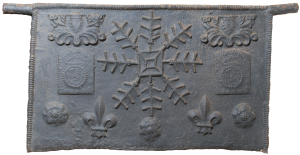
HASTINGS MUSEUM, John’s Place, Bohemia Road, Hastings, TN34 1ET
This museum has the second largest collection of firebacks in the UK but these are not on display at present.
VICTORIA & ALBERT MUSEUM, Cromwell Road, South Kensington, London, SW7 2RL
There are also some fine examples of firebacks made in the Weald on display in the Metalwork Gallery in the V&A. You can search for images of the museum’s collection HERE
PETWORTH HOUSE (National Trust), Petworth, West Sussex, GU28 9LR
A collection of 61 firebacks, mostly continental designs but a few from the Weald, can be seen displayed along the Servants’ Corridor. A descriptive catalogue of them is available. Other Wealden firebacks can be seen in fireplaces in the house. In an inventory of the contents of the old Petworth House in 1632, 21 firebacks were recorded. Details about opening times can be seen HERE.
Other National Trust properties, notably Bateman’s, Rudyard Kipling’s former home at Burwash, and Ightham Mote, near Sevenoaks, have several Wealden firebacks in their fireplaces, as does Penshurst Place which is privately owned.
THE GRANGE, The Green, Rottingdean, East Sussex, BN2 7HA
There is a small number of firebacks here, some of the collection formerly in Brighton Museum, including a rare original wooden pattern, one of only five known from Britain. Details about opening times can be seen HERE.
GUNS
From the mid-16th to the late-18th centuries the Weald was the principal source of iron cannon for the navy and for coastal defence but few examples can seen in the region, the majority surviving where they were used in former British possessions around the world. For example, there are many on Caribbean islands and around the eastern coast of Canada.
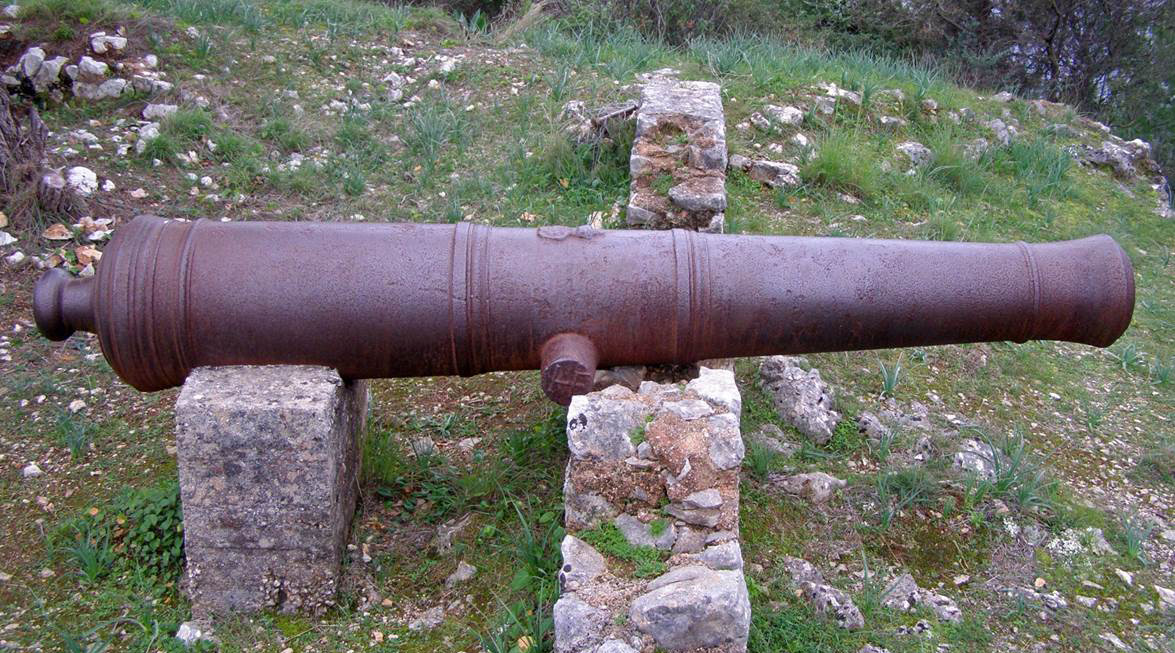
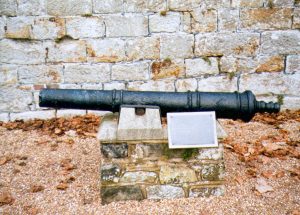
Three guns made in the Weald, however, can be seen in Sussex locations: at Pevensey Castle, one of two demi-culverins (that fired 9lb shot) placed there in the 16th century for the defence of Pevensey Harbour; in the High Street of the village of Mayfield, a falcon (which fired a 2lb shot) and which was probably cast at Sir Thomas Gresham’s furnace just north of the village; and at Horsham Museum is a 9-pounder that was cast at the furnace at Brede in the early-18th century.
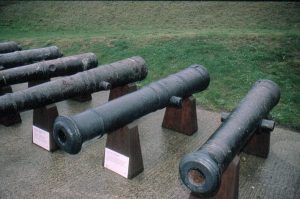
FORT NELSON, Portsdown Hill Road, Portsmouth, PO17 6AN
The fort was built to protect Portsmouth harbour against the threat of invasion, but is now a Royal Armouries Museum. It has an impressive collection of weaponry through the centuries, including cannon made at furnaces in the Weald.
Visit the museum’s website to find out opening times and admissions.
IRON GRAVESLABS
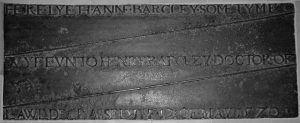
These were not an important commercial product of the Wealden furnaces, but from the 16th century over 100 people directly or indirectly associated with the iron industry were laid to rest beneath iron plates instead of beneath the more familiar, engraved ledger stones. There are over 80 iron graveslabs in churches in south-east England but the largest number surviving – 33 – are at the church of St Peter & St Paul, Wadhurst in East Sussex. The picture shows the earliest dated iron graveslab, made for the wife of the local Member of Parliament, which is in St Swithun’s church in East Grinstead.
A smaller number of iron graveslabs are also to be found in churches in the west Midlands and Yorkshire.
A Catalogue of Pre-Industrial Revolution Iron Graveslabs in England was compiled by Rosalind Willatts and first published on microfiche in Sussex Archaeological Collections, 125 (1987). It was subsequently printed in Wealden Iron, 2nd series, 8 (1988), 12-47.
This catalogue, with later additions, corrections and amendments can be downloaded (pdf)
Photographs of 84 of the graveslabs in the catalogue can be viewed in the Photo Archive: Wealden iron graveslabs
© Wealden Iron Research Group 2000-25.
